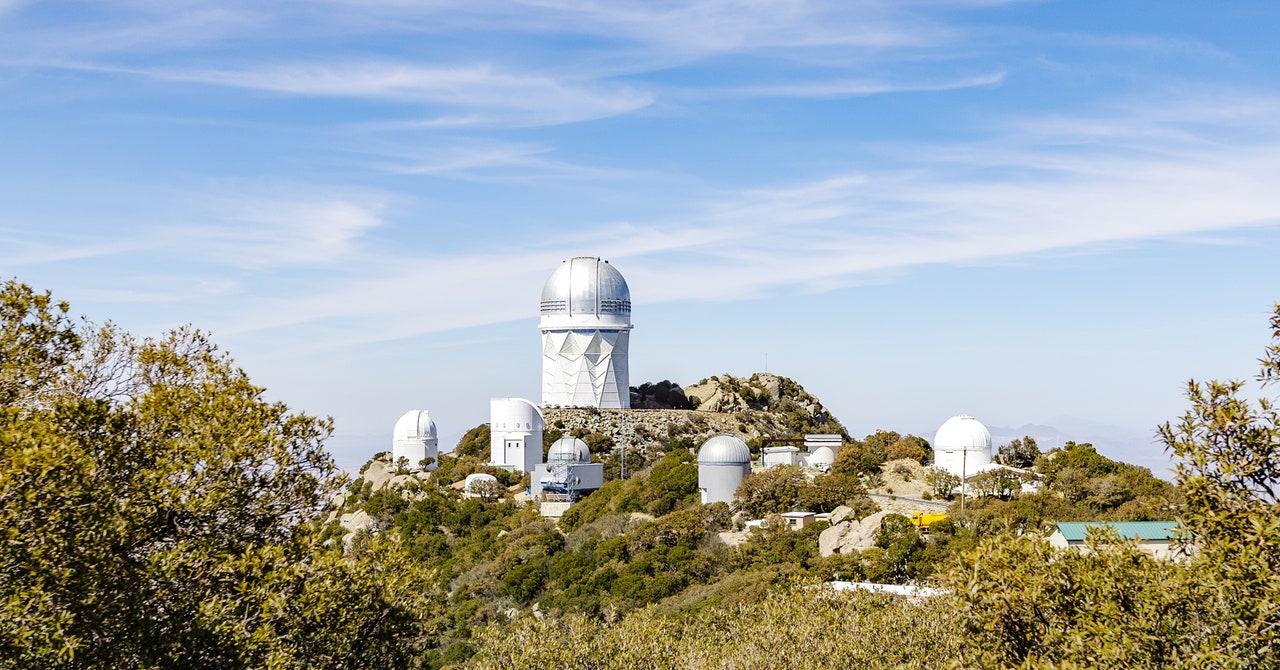
It was 4 am on June 17 when Michelle Edwards, associate director of Kitt Peak National Observatory, got the news: A wildfire had breached the road up to the telescopes. She felt a little bit of fear, even though she’d already spent several long days coordinating the observatory’s protection plan, turning her office into a command center for a firefighting effort. “I don’t think you can ever really anticipate that phone call,” Edwards says.
The Contreras wildfire had been triggered by a lightning strike six days prior on Tohono O’odham nation lands in Arizona, a few miles southeast of the summit where Kitt Peak is located. Winds and dry vegetation quickly propelled the flames to burn through 500 acres, prompting Edwards to initiate an evacuation of nonessential personnel as a fire crew descended on the site a few days later. Then, they prepared for the worst: Firefighters cleared away brush and spread flame retardant. Teams of essential personnel visited each of Kitt Peak’s 23 telescopes, covering up domes and powering down electronics.
On June 17, the fire blazed right up to many of the telescopes on the southwest ridge of the summit, destroying a cabin, dormitory, and utility shed. The flames damaged at least 18 power poles, wiping out electricity and data service, meaning that science operations at the observatory won’t resume until at least the end of August. “Arizona is unfortunately becoming a hotbed for wildfires,” Edwards says. “And we have seen impact from fire before at Kitt Peak, although nothing as bad as this.”
Kitt Peak isn’t the first observatory threatened as climate change exacerbates the severity of wildfires. Other research fields, which depend on access to glaciers, snow, and remote weather stations, are facing similar warming-related problems. “It’s just another example of how so many important human endeavors are at risk,” says San Francisco State University’s Adrienne Cool, who cofounded a global nonprofit called Astronomers for Planet Earth, or A4E.
In 2011, a massive wildfire endangered the McDonald Observatory in Texas. A bushfire swept over Australia’s Siding Spring Observatory in 2013. Two years ago, California’s Lick Observatory narrowly avoided destruction, though flames did nearly $8 million worth of damage to surrounding homes and consumed an amateur observatory nearby. One month later, Mount Wilson Observatory in Los Angeles had a close call with a wildfire that raged within a few hundred feet of the site.
Deciding where to build an observatory is strategic: Astronomers pick locations with reliably good weather, stable atmospheres, and clear skies—like mountains—so that telescopes will be functional for decades to come. (Lick, the oldest mountaintop observatory in the world, has been operating since 1888; Kitt Peak’s first domes were constructed nearly 70 years ago.) “We build our telescopes out in the sun and in dry locations,” says A4E founding member Travis Rector, an astronomer at the University of Alaska Anchorage. “And those are perfect conditions for forest fires.”
Fires aren’t the only natural disaster putting observatories at risk. Puerto Rico’s Arecibo Observatory suffered damage from Hurricane Maria in 2017. (It was further damaged by a snapped cable in 2020 and collapsed a few months later.) The Atacama Desert—one of the world’s best places to put a telescope, according to Rector, because of its historical lack of rain—now endures regular storms and flooding. Last month, the Cerro Tololo Inter-American Observatory in Chile shut down due to one of the largest snowstorms the area has had. It’s not that extreme weather never happened before, Rector says, but climate change is making it more frequent and more intense. It’s also affecting the research itself: As temperatures rise, the quality of telescope imaging gets worse.


